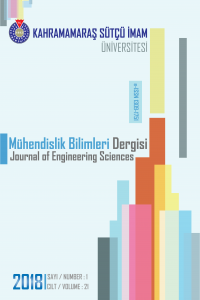Abstract
Sanayileşmenin ve modern hayatın
en önemli ihtiyaçlarından birisi olan enerjinin depolanarak bir yerden bir yere
taşınabilmesi her geçen gün güncelliğini arttırmaktadır. Fakat bu gelişmeyle
birlikte bir takım çevresel sorunlarıda açığa çıkmaktadır. Kullanım ömrünü
doldurmuş pillerin çevreye gelişi güzel bırakılması ciddi metal kirliliklerine
sebep olmaktadır. Ayrıca geri dönüştürülebilir malzeme yapısından dolayı da
ciddi ekonomik kayıplara yol açmaktadır.
Bu çalışmada, Kahramanmaraş Büyükşehir
Belediyesi sınırları içerisinde üç atık pil toplama noktası belirlenmiş ve üç
ay içerisinde bu noktalarda toplanan bitmiş piller alınarak
sınıflandırılmıştır. Çalışma sonuçlarından elde edilen veriler TAP’dan ve TUİK’den
elde edilen veriler doğrultusunda birleştirilmiştir. Atık piller türlerine göre
sınıflandırılmış ve pil türlerinin kullanım potansiyelleri üzerinde tespitlerde
bulunulmuştur. Ayrıca Kahramanmaraş ile aynı nüfus yogunluğuna sahip şehirlerde
toplanan atık pil miktarları karşılaştırılmıştır. Son olarak Kahramanmaraş için
gelecekte kurulabilecek atık pil işleme tesisi için bir takım önemli veriler
elde edilmiştir.
References
- [1] Crompton, T.R. (2000) “Battery Reference Book, 3rd Ed.”, Reed Educational and Professional Publishing Ltd., Woburn. [2] Sayilgan, E., Kukrer, T., Civelekoglu, G., Ferella, F., Akcil, A., Veglio, F., Kitis, M. (2009) “A review of technologies for the recovery of metals from spent alkaline and zinc–carbon batteries”, Hydrometallurgy, 97, No. 3-4, p. 158. [3] Pistoia, G., Wiaux, J.P., Wolsky, S.P., (2001) “Used Battery Collection and Recycling”, Industrial Chemistry Library Vol. 10, Elsevier Science B.V., Amsterdam. [4] Bernardes, A.M., Espinosa, D.C.R., Tenório, J.A.S. (2004) “Recycling of batteries: a review of current processes and Technologies”, J. Power Sources, 130, No. 1-2, p. 291. [5] TUİK 2016 nüfus sayımı, http://www.tuik.gov.tr/PreIstatistikTablo.do?istab_id=1590, erişim tarihi: 25 Mart 2017. [6] Dolaz, M , Bozdoğan, N , Zıba, C . (2016). Kahramanmaraş Merkez İlçesi ve Bazı Mahallelerindeki Cam, Plastik ve Kağıt Atık Potansiyelinin Belirlenmesi. Kahramanmaraş Sütçü İmam Üniversitesi Mühendislik Bilimleri Dergisi, 19 (3), 68-75. [7] Linden, D., B. Reddy T. (2002) “Handbook of Batteries”, 3rd edition, McGraw-Hill, New York. [8] Pil türleri, https://en.wikipedia.org/wiki/List_of_battery_sizes, erişim tarihi: 20 Mart 2017. [9] TAP 2016 yılı verileri, http://tap.org.tr , erişim tarihi: 15 Mart 2016.
Abstract
One of the most important needs of modern life is energy, which is
stored in a place and moved from one place to another increases every day. However,
some environmental problems are becoming increasingly apparent with this
development. After using for a long time batteries they are died. Dead
batteries are also causes serious metal contamination or metal pollution when
they are given randomly the environment. In addition, they cause significant
economic losses due to containing of recyclable materials.
In this study, three waste battery collection points located within the
borders of Kahramanmaras Metropolitan Municipality were identified and the
finished batteries collected at these points were classified within three
months. The data obtained from the study results were combined in the direction
of the data obtained from TAP and TUIK. Waste batteries are classified
according to their types and the potential for use of battery types has been
determined. In addition, the amounts of waste batteries collected in the cities
with the same population density as Kahramanmaras were compared. Finally, a
number of important data have been obtained for the future waste battery
processing plant for Kahramanmaras.
References
- [1] Crompton, T.R. (2000) “Battery Reference Book, 3rd Ed.”, Reed Educational and Professional Publishing Ltd., Woburn. [2] Sayilgan, E., Kukrer, T., Civelekoglu, G., Ferella, F., Akcil, A., Veglio, F., Kitis, M. (2009) “A review of technologies for the recovery of metals from spent alkaline and zinc–carbon batteries”, Hydrometallurgy, 97, No. 3-4, p. 158. [3] Pistoia, G., Wiaux, J.P., Wolsky, S.P., (2001) “Used Battery Collection and Recycling”, Industrial Chemistry Library Vol. 10, Elsevier Science B.V., Amsterdam. [4] Bernardes, A.M., Espinosa, D.C.R., Tenório, J.A.S. (2004) “Recycling of batteries: a review of current processes and Technologies”, J. Power Sources, 130, No. 1-2, p. 291. [5] TUİK 2016 nüfus sayımı, http://www.tuik.gov.tr/PreIstatistikTablo.do?istab_id=1590, erişim tarihi: 25 Mart 2017. [6] Dolaz, M , Bozdoğan, N , Zıba, C . (2016). Kahramanmaraş Merkez İlçesi ve Bazı Mahallelerindeki Cam, Plastik ve Kağıt Atık Potansiyelinin Belirlenmesi. Kahramanmaraş Sütçü İmam Üniversitesi Mühendislik Bilimleri Dergisi, 19 (3), 68-75. [7] Linden, D., B. Reddy T. (2002) “Handbook of Batteries”, 3rd edition, McGraw-Hill, New York. [8] Pil türleri, https://en.wikipedia.org/wiki/List_of_battery_sizes, erişim tarihi: 20 Mart 2017. [9] TAP 2016 yılı verileri, http://tap.org.tr , erişim tarihi: 15 Mart 2016.
Details
| Primary Language | Turkish |
|---|---|
| Subjects | Environmental Engineering |
| Journal Section | Research Article |
| Authors | |
| Publication Date | March 30, 2018 |
| Submission Date | April 12, 2017 |
| Published in Issue | Year 2018 Volume: 21 Issue: 1 |

